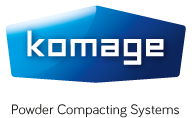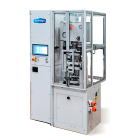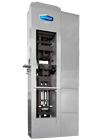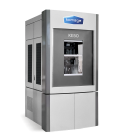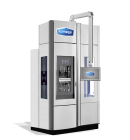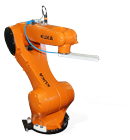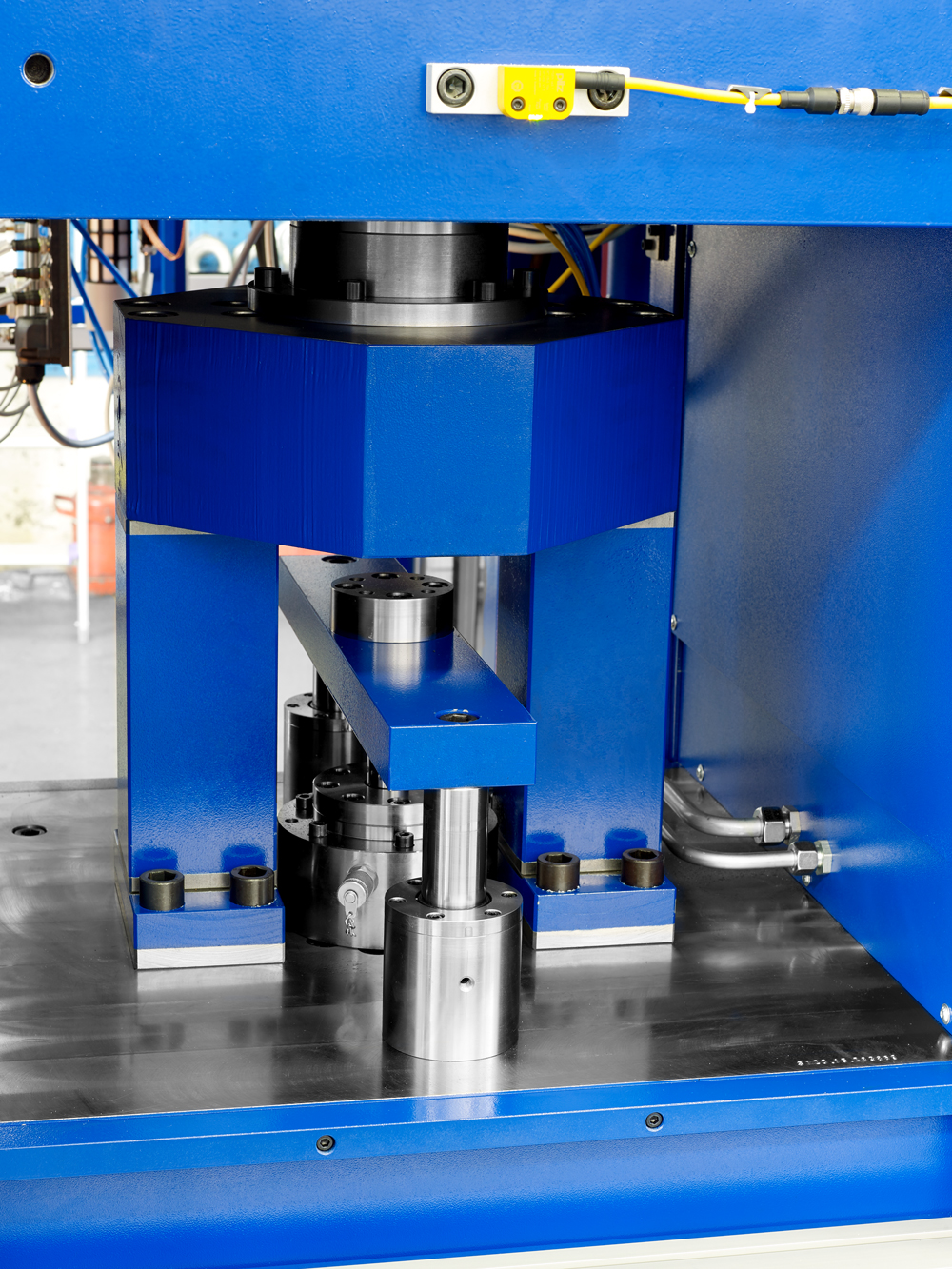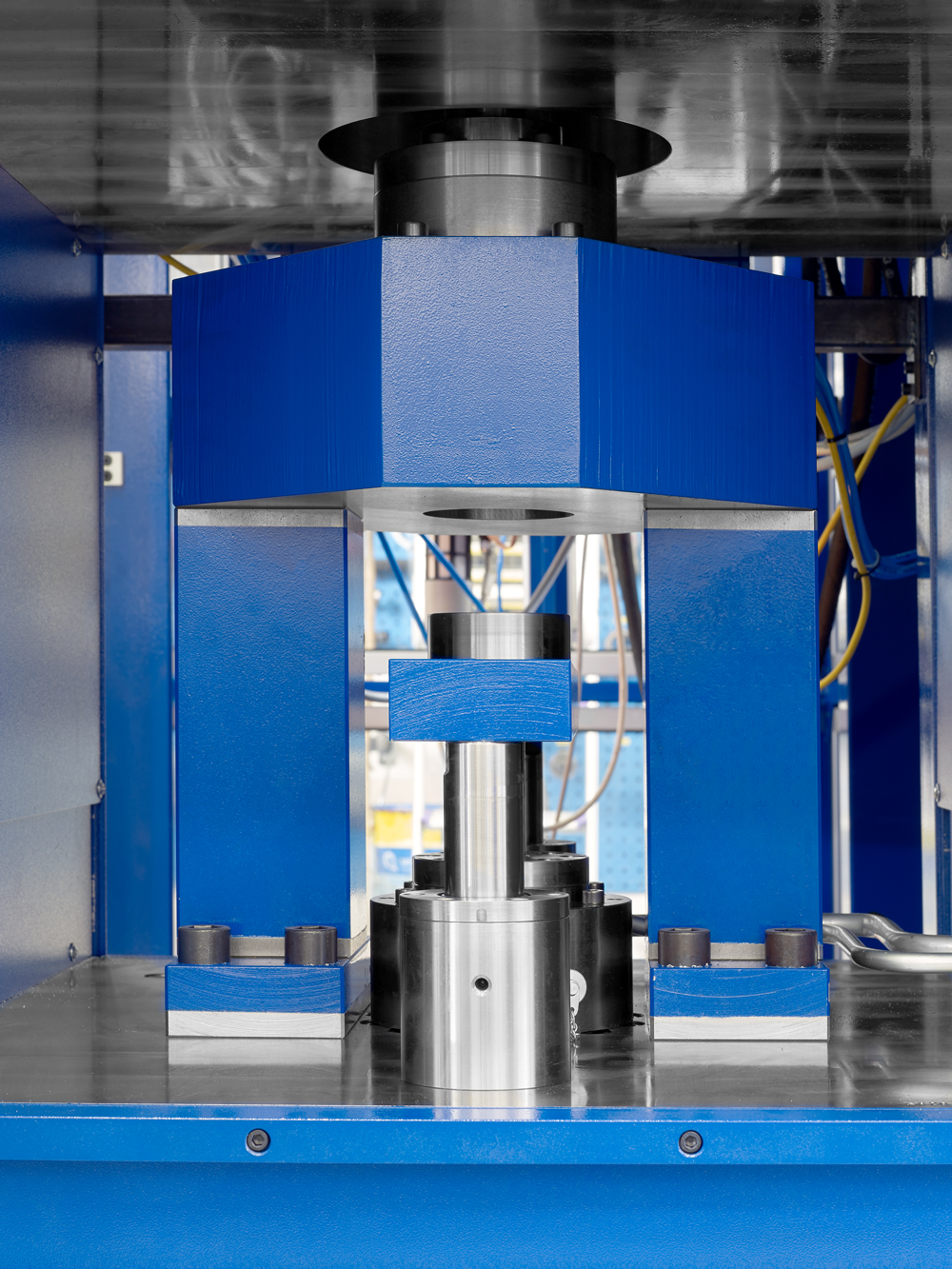Glossary
Adaptor
The adaptor is used to hold and guide the top punch, bottom punch, die and core rod if this is necessary. By using the adaptor, the tool elements are assembled outside the press and are installed in the Komage powder press as a unit so that shortened retooling times are achieved. Adaptors which are able to hold several punches are referred to as multi-level adaptors (multi-level system).
Applied load
The applied load is a mechanically, pneumatically or hydraulically designed supplementary device which is mounted on the top punch holder. It is used for crack-free demolding of the pressed parts and is used where very fine masses, which tend to trap air, delaminate during normal demolding. In this case, the top punch remains on the pressed part with defined force to give the entrapped air the opportunity to escape from the pressed part outside the die after being removed completely.
Core rod
Core rods can be used to produce continuous axial openings in the pressed part. Any number of core rods can be implemented taking into account the cross-section of the pressed part and the core pin. The core rod is designed to be fixed or movable in the axial direction in line with press-technical requirements. In this case, the core rod can be executed as controlled or position-controlled so that press-technical advantages emerge, such as during filling of thin-walled pressed parts or by reducing tool wear during demolding (core rod release). The upper edge of the core rod is flush with the upper edge of the die when the die is being filled. Subsequently, the top punch travels into the die to compact the powder. The friction forces on the die wall and the core rod rise as compaction of the powder increases. These forces act in opposition to the pressing force of the top punch. A reduction of the frictional forces is possible with core rod release, although this becomes force-free on exceeding a defined position in the press sequence. Subsequently, the free-floating core rod takes up a free position depending on the friction ratios in the press tool.
Ejection principle
The ejection principle is one of the methods for removing the pressed part from the die (demolding). Demolding in this case is carried out with the bottom punch which, after compaction, pushes the pressed part out of the fixed die until it is exposed over its entire length. The top punch is then retracted so that the pressed part can be taken off. The main advantage of a fixed die is that, unlike with the withdrawal principle, the filling system is at one level during the entire pressing process which largely reduces powder segregation in the fill shoe. It is also possible to implement a constant take-off height of the pressed parts and to easily connect a handling system.
Filling (gravity filling)
This refers to the free fall of the powder into the already open die. The filling space is created by a relative movement between die and bottom punch. Depending on the pressing process, either the die or the bottom punch is moved for this before the die fill shoe moves over the die opening for filling.
Filling (suction filling)
During suction filling, the die opening is initially closed, i.e. the upper edge of the die and the bottom punch form a common plane. The powder is fed in by a relative movement of the die and bottom punch so that the powder is sucked into the filling chamber due to the negative pressure generated. Better fills are achieved in this way as there can be no occurrence of any air gap that affects the bulk density between the bottom punch and the molding compound.
Fixed stops
Mechanical fixed stops offer a way of adjusting the end position of the pressing axes and of absorbing pressing forces. They can be used in particular when pressing stepped geometries. A mechanical adjustment is necessary for the adaptation of a new product. This may take some time and may therefore have an adverse effect on the use of a fixed stop. It is because of this that fixed stops are not used in the Komage powder presses of the S Series. Here, the flexibility of servo-hydraulically controlled punch axes combined with a program matched to the product enable fast and accurate positioning of the axes. In addition, the program data can be stored for each product and called up again for a product change, something that is not possible when mechanical fixed stops are used. Furthermore, the regulated punch axes can approach any position and hold it hydraulically for a defined time. Another advantage is that the punches are not limited in their movement by fixed stops. The pressure on them can be relieved counter to their press direction after the pressing process in order to compensate spring-back effects in the tool and pressed part, and to prevent cracking.
Multi-layer
The multi-layer technology provides the opportunity to construct components from several layers and materials. The aim is to form a pressed part from a cheap base material and a high-quality functional material. Increased demands are placed particularly on the machine equipment and the press control system when manufacturing such multi-layer components. This technology can be used on Komage powder presses which have freely programmable, independent axes of motion. Up to three filling axes can be provided for the production of multi-layer components depending on customer requirements and available space. With only one filling axis, a multi-cavity fill shoe can be used for applying the different layers. Thanks to a control system developed by Komage, it is also possible to program different filling heights in conjunction with freely programmable punch axes.
Multi-level systems
What are commonly referred to as multi-level systems are used for the production of complex parts with unequal heights and cross-sections. They have several controlled punch axes with correspondingly designed tools that can be moved independently of each other in order to achieve an optimum density distribution in the pressed part. The individual punch axes can not only take up any required position, they can also carry out defined powder transfers in divided punches. Furthermore, all punch axes can be synchronized with the top punch movement so that both accelerated and delayed speeds are programmable. As a result, uniform and crack-free pressing of top and bottom punch can take place and the press neutral can be placed at any required position of the molded part. Depending on the application, forces and paths of the individual axes can easily be adjusted and the number of levels can be expanded subsequently.
Pressing – from above
In this pressing process, only the top punch exerts pressure on the powder while the bottom punch and die have a firm seat or are held in position. As the pressure increases, the powder particles lying on the top punch are more severely deformed than the particles lying further away. At the same time, the powder particles slide past each other to fill the remaining space below each other and to form solid compounds. The result is that the density of the powder on the top punch is higher than in the remaining pressed part.
Pressing – from below
During pressing from below, only the bottom punch exerts pressure on the powder, top punch and die are held in position or have a firm seat. As the compressive pressure is present on the end face of the bottom punch, this is where the highest density occurs and it decreases towards the top punch.
Pressing – to density/height
There are basically two ways to achieve the desired density of a pressed part. When pressing to height, the position of the punch is controlled so that a precise position is approached (scaling 0.01 mm) during each pressing operation. The density of the pressed part can be varied by the amount of the powder poured into the die. When pressing to density, the variable to be controlled is the force with which the powder is compressed. This is then determined by the pressure on the punch. With this method, the height of the part to be pressed can be determined by adjusting the amount of powder. Variations in the buildup of force or the height of the part can be detected by means of an automatic fill correction and insufficient powder filling can be indicated. Corrective action regarding the filling process can be taken based on a freely programmable range of tolerance for force or height.
Pressing – two-sided pressing with fixed die
In this pressing process, top and bottom punches are freely movable, while the die table has a firm seat. With the appropriate press, the speed of the top and bottom punch can be programmed so that a homogeneous density distribution occurs in the pressed part and the press neutral is adjusted in the required area. Upper and lower punches are moved synchronously upwards according to the ejection principle to remove the pressed part from the die.
Pressing – two-sided pressing with floating die
In this form of two-sided pressing, the die table is held by means of springs, pneumatic or hydraulic pistons. In this application, the bottom punch stands on a fixed base plate while the top punch carries out the compaction process by means of a downward movement. When the top punch meets the powder, a friction force occurs between powder and die wall. As the punch penetrates deeper into the die, the friction forces on the die wall become greater than the die's counterforce. The result of this is that the die moves downwards to the fixed bottom punch at the same speed as the top punch moving upwards. The resulting relative movement of the bottom punch is the result of a reversing pressing process which then leads again to the creation of friction forces as the downward movement of the die continues. These forces will increase until the friction forces at the top punch are cancelled and the top punch penetrates into the die again. The process is repeated until the preset pressing force is reached.
Pressing – two-sided pressing with forcibly controlled die
In this method, the die is forcibly carried along with the top punch movement from a point to be defined by means of a cam or an adjustable driving column which is pretensioned. As in this case the die assumes the speed of the top punch and pressing is initiated from below, it is important to interrupt the die movement and to lock it downwards at the same time. This leads to the initiation of unilateral pressing from above which is also referred to as re-pressing. The consequence is that a uniform density is created, particularly in the case of stepped molded parts. The die can then be unlatched and released for demolding. Delayed or accelerated speeds between top punch and die are only possible in presses with controlled axes.
Product data acquisition/product data history
Product data acquisition is a flexible software tool which can be used on Komage powder presses to document complete orders for manufacturing a finished pressed part. In this case, product data defined for each production order, such as target force, pressing force of each individual axis, pressed part height or weight (if scales are connected), are recorded for each press stroke. The values are then grouped together in a data module which enables transfer to a spreadsheet program. The parameters to be recorded can be adjusted to the customer's wishes.
Removal systems (automation or handling systems)
A removal system is used for automated removal and setting down of the pressed parts for which various processing steps may take place. In this case, a common control system for the pressing and removal system enables optimal integration of pressed part handling in the press cycle. Several linear axes or robots, which are equipped, for example, with a suction or gripping unit, may be used to remove the pressed parts. It is also possible to set down the pressed parts in a deburring station in which they are deburred using compressed air. The pressed parts can then be placed on a scale and weighed. The weight is displayed on the operator panel and can be used for automatic correction of the filling level. The pressed parts can be conveyed out of the machine unit by connecting up a conveyor belt. Alternatively, they can also be set down directly on a sintering plate. Due to the flexible control, there is also an option to release individual pressed parts to a bad parts position.
Table programming
Table programming represents a flexible programming tool which enables the operator to guide the movement of the pressing and filling axes at will. The main advantage when creating the pressing program is that it is not bound by fixed sequences and any number of additional movements can be programmed. The program is made up of multiple sets which are executed gradually. In each individual set, a position and speed is programmed for each axis. In addition, every set is given so-called H and B functions. With the help of H functions, also known as auxiliary functions, one or more axes can perform certain functions, such as pressing with different speeds and positional tolerances. Furthermore, it is possible to activate additional functions in this way, such as adding in an applied load, activation of a shaking movement of the filling box or even cleaning of the tools, to name but a few. Using the B functions, or operating functions, the speeds are calculated for simultaneous positioning of the X and Y axes and they are entered in the appropriate input fields.
Withdrawal principle
In the withdrawal principle, the bottom punch has a fixed seat during the entire pressing process, while the top punch and the die are freely movable. When pressing the powder with the top punch, the die also moves completely or partly downwards depending on the pressing process. When the pressing process has finished, the die is drawn downwards until the pressed part is exposed along its entire length. The top punch is then retracted so that the pressed part can be removed.

